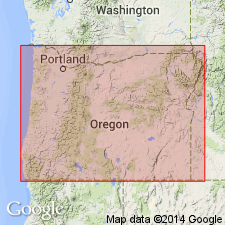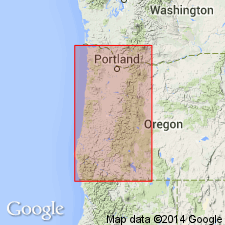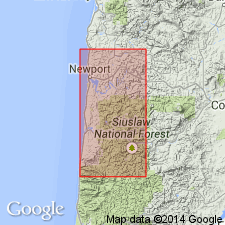
- Usage in publication:
-
- Nye shale
- Modifications:
-
- Overview
- AAPG geologic province:
-
- Western Columbia basin
Summary:
Pg. 269. Nye shale. Shales of late Oligocene age. Type locality in Lincoln County, northwestern Oregon. Regarded as older than Aturia bed and younger than Eugene formation.
[Name adopted from ms. rpt. of H.G. Schenck; see H.G. Schenck, 1928, California Univ. Pub., Dept. Geol. Sci. Bull., v. 18., no. 1, table opp. p. 4.]
Source: US geologic names lexicon (USGS Bull. 896, p. 1522-1523).

- Usage in publication:
-
- Nye shale
- Modifications:
-
- Principal reference
- AAPG geologic province:
-
- Western Columbia basin
Summary:
Pg. 450, 456, 459. Nye shale. Dark concretionary shales; on fresh exposures black, massive, jointed, and might more properly be termed a mudstone. [No thickness given.] Replaces "Acila shales" (paleontologic term) of Harrison and Eaton. Underlies, probably unconformably, the Miocene deposits of the area and rests, with apparent unconformity, on Yaquina formation. Assigned to upper Oligocene.
Type locality: town of Newport and at Nye Beach, in NW/4 sec. 5, T. 11 S., R. 11 W., Lincoln Co., northwestern OR.
Source: US geologic names lexicon (USGS Bull. 896, p. 1522-1523).

- Usage in publication:
-
- Nye shale
- Modifications:
-
- Overview
- AAPG geologic province:
-
- Western Columbia basin
Summary:
Table opp. p. 4. Nye shale of Smith, 1926, was adoped from ms. rpt. of H.G. Schenck. [Age is late Oligocene.]
Source: US geologic names lexicon (USGS Bull. 896, p. 1522-1523).

- Usage in publication:
-
- Nye mudstone*
- Modifications:
-
- Adopted
- Areal extent
- AAPG geologic province:
-
- Western Columbia basin
Summary:
Nye mudstone. Described in Newport-Waldport area, [northwestern Oregon], as sequence of approximately 2,500 feet of black massive mudstones. Disconformably overlies Yaquina sandstone; unconformably underlies Astoria formation. [Age is early Miocene.]
Source: US geologic names lexicon (USGS Bull. 1200, p. 2786).
For more information, please contact Nancy Stamm, Geologic Names Committee Secretary.
Asterisk (*) indicates published by U.S. Geological Survey authors.
"No current usage" (†) implies that a name has been abandoned or has fallen into disuse. Former usage and, if known, replacement name given in parentheses ( ).
Slash (/) indicates name conflicts with nomenclatural guidelines (CSN, 1933; ACSN, 1961, 1970; NACSN, 1983, 2005, 2021). May be explained within brackets ([ ]).

